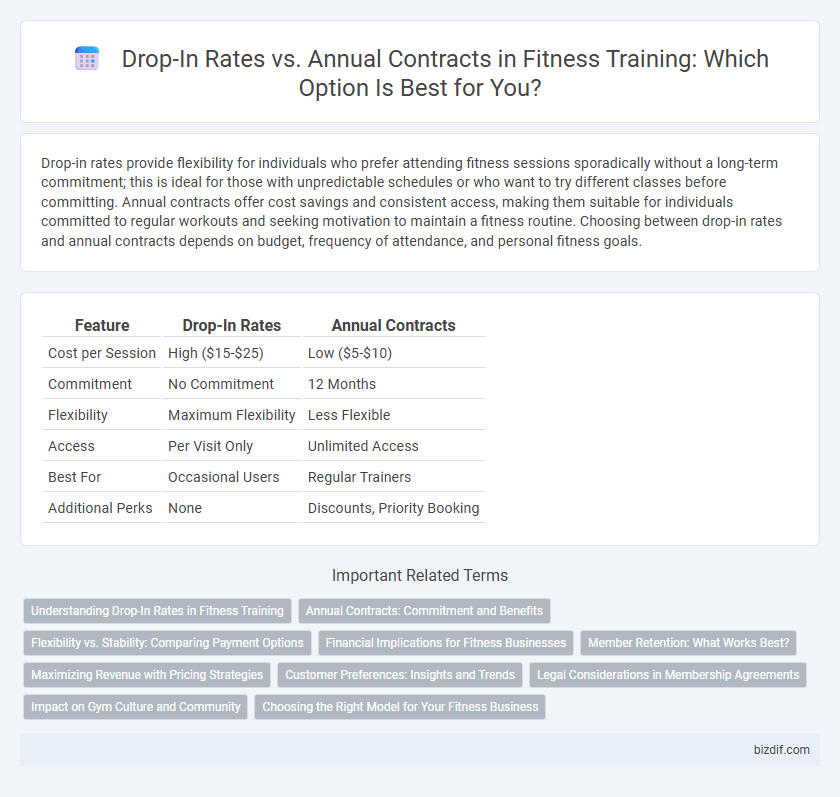Drop-in rates provide flexibility for individuals who prefer attending fitness sessions sporadically without a long-term commitment; this is ideal for those with unpredictable schedules or who want to try different classes before committing. Annual contracts offer cost savings and consistent access, making them suitable for individuals committed to regular workouts and seeking motivation to maintain a fitness routine. Choosing between drop-in rates and annual contracts depends on budget, frequency of attendance, and personal fitness goals.
Table of Comparison
| Feature | Drop-In Rates | Annual Contracts |
|---|---|---|
| Cost per Session | High ($15-$25) | Low ($5-$10) |
| Commitment | No Commitment | 12 Months |
| Flexibility | Maximum Flexibility | Less Flexible |
| Access | Per Visit Only | Unlimited Access |
| Best For | Occasional Users | Regular Trainers |
| Additional Perks | None | Discounts, Priority Booking |
Understanding Drop-In Rates in Fitness Training
Drop-in rates in fitness training offer flexible, pay-as-you-go access to gym facilities or classes, ideal for individuals with unpredictable schedules or those wanting to test a program before committing. These rates typically cost more per session compared to annual contracts but provide freedom without long-term financial obligations. Understanding drop-in rates helps clients weigh immediate convenience and varied workout experiences against the cost savings and consistency offered by annual memberships.
Annual Contracts: Commitment and Benefits
Annual contracts in fitness training offer structured commitment that encourages consistent workout habits and long-term progress. These contracts often include benefits such as reduced monthly rates, access to a wider range of classes, personalized training plans, and priority booking. Members with annual contracts experience improved motivation and accountability, leading to better fitness outcomes over time.
Flexibility vs. Stability: Comparing Payment Options
Drop-in rates offer maximum flexibility by allowing clients to pay per session without long-term commitment, ideal for irregular schedules and testing different fitness programs. Annual contracts provide stability with fixed payments, often including discounts and guaranteed access to classes, supporting consistent workout routines and long-term fitness goals. Choosing between these options depends on balancing the need for flexibility against the benefits of commitment and cost savings.
Financial Implications for Fitness Businesses
Drop-in rates offer fitness businesses immediate revenue per visit but lack predictable cash flow, potentially leading to fluctuating monthly income. Annual contracts secure upfront payments, enhancing financial stability and enabling better budget forecasting while reducing customer churn. Balancing these pricing models strategically helps optimize revenue streams and operational planning for fitness centers.
Member Retention: What Works Best?
Drop-in rates provide flexibility that attracts casual gym-goers but often result in lower member retention due to lack of commitment. Annual contracts encourage consistent attendance and foster long-term habits, leading to higher retention rates and better overall fitness outcomes. Data shows gyms with annual memberships experience a 30% higher member retention rate compared to those relying primarily on drop-in clients.
Maximizing Revenue with Pricing Strategies
Drop-in rates provide flexibility and attract casual clients willing to pay a premium for single sessions, generating immediate cash flow and high per-visit revenue. Annual contracts secure long-term commitments, ensuring steady income and improved client retention, which lowers marketing costs and increases lifetime customer value. Combining both strategies enables fitness businesses to capture diverse customer segments and maximize revenue through optimized pricing tiers and membership options.
Customer Preferences: Insights and Trends
Customer preferences in fitness training reveal a growing demand for flexible drop-in rates over rigid annual contracts, driven by changing lifestyles and unpredictable schedules. Data from recent market analyses indicate a 35% increase in drop-in session bookings compared to a steady decline in long-term memberships. Trends suggest that clients prioritize convenience and lower commitment, influencing gyms to offer more customizable pricing models to attract and retain members.
Legal Considerations in Membership Agreements
Drop-in rates provide flexibility but often come with fewer legal obligations compared to annual contracts, which require a detailed membership agreement outlining cancellation policies, payment terms, and liability waivers. Annual contracts must comply with consumer protection laws, ensuring clear disclosure of terms to avoid disputes over fees and service expectations. Legal considerations in these agreements also include adherence to local regulations on contract enforceability and the member's right to refund or termination.
Impact on Gym Culture and Community
Drop-in rates encourage flexibility and attract a diverse range of members, fostering a dynamic and inclusive gym culture. Annual contracts build a committed community by promoting consistent attendance and long-term relationships among members and trainers. Balancing both options helps gyms cultivate an engaging environment while maintaining financial stability and member loyalty.
Choosing the Right Model for Your Fitness Business
Analyzing drop-in rates versus annual contracts reveals critical revenue patterns for fitness businesses; drop-in rates attract casual clients seeking flexibility, while annual contracts ensure steady cash flow and higher client retention. Tailoring the pricing model to your target market's preferences and workout frequency enhances customer satisfaction and maximizes profitability. Implementing a hybrid approach allows gyms to capture diverse clientele by combining immediate accessibility with long-term commitment incentives.
Drop-In Rates vs Annual Contracts Infographic

 bizdif.com
bizdif.com